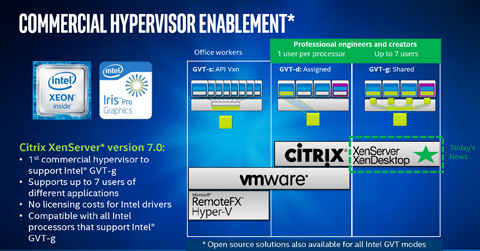
‘Virtualised’ Intel Iris Pro graphics (GVT-g) is now supported on Citrix XenServer 7.0
Intel has again boosted the 3D performance of its Xeon-integrated Iris Pro graphics technology. The company says its Intel Iris Pro Graphics P580, embedded in the new ’Skylake’ Intel Xeon E3-1585 v5 CPU, can deliver up to 26 per cent more 3D performance than the previous generation ‘Broadwell’ Intel Xeon E3-1285 v4 with Iris Pro Graphics P6300.
Interestingly, Intel’s initial focus for this graphics technology is on data centres and not desktop workstations.
Here, 3D CAD applications run on servers inside the data centre, while designers and engineers connect remotely using low powered clients.
The new ‘Skylake’ Intel Xeon E3-1585 v5 CPU is a quad core chip running at 3.5GHz. It will likely be found in systems like the HP Moonshot that can host up to 45 mini workstations, each on a cartridge with its own Intel Xeon E3 series CPU, memory and SSD storage.
For best performance most CAD users will likely connect to these ‘mini workstations’ over a 1:1 connection using the direct mode in Intel’s Graphics Virtualisation Technology (Intel GVT-d). With a direct connection, the cost and complexity of software is also reduced as firms don’t need a hypervisor.
However, it is also possible to ‘virtualize’ Intel Iris Pro graphics. In GVT-g mode up to seven users can work off the same physical Intel Xeon E3-1500 v5 series CPU, with the graphics processor broken up into multiple ‘instances’.
Of course, by sharing physical processing resources, performance will almost certainly take a hit. Intel says GVT-g mode is good for less complex 3D CAD applications, but it’s highly dependent on the size and complexity of the CAD model.
An Intel spokesperson told DEVELOP3D that GVT-g could be the desired mode if a user is collaborating with other designers or showing a design at a customer site.
While virtualisation software specialists Citrix and VMWare have supported GVT-d mode for some time, support for Intel GVT-g mode has historically only been through open source hypervisors. This changed recently with Citrix announcing support for GVT-g in XenServer version 7.0 earlier this month.
Intel is already getting the seal of approval from CAD software developers. CAD applications that are certified on Citrix for Intel GVT-g include AutoCAD, Inventor, Revit, SolidWorks, Siemens NX and TeamCenter Viz.
The company is also increasing support for OpenGL features, which are important for visual quality in some CAD applications. Intel says the new Intel Xeon E3-1500 v5 with Intel Iris Pro graphics P580 can support Multi-sample anti-aliasing (MSAA) to sharpen edges of models and Order Independent Transparency (OIT) for faster and more accurate transparency in applications like Solidworks, Creo, and Siemens NX.






